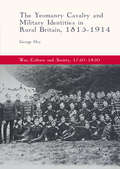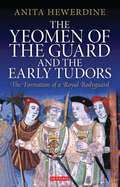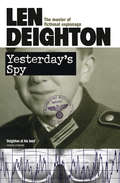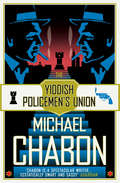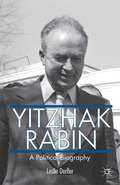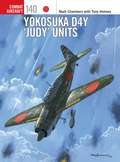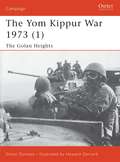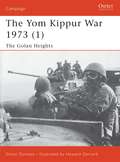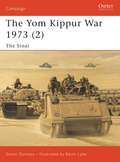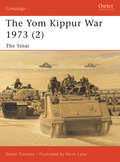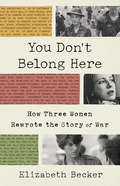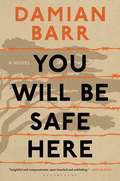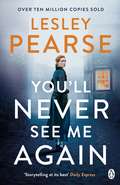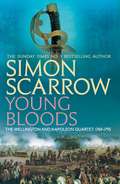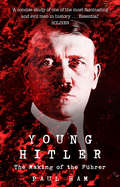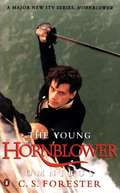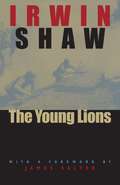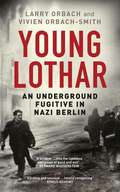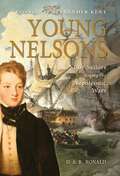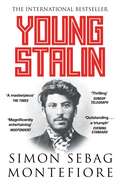- Table View
- List View
The Yeomanry Cavalry and Military Identities in Rural Britain, 1815–1914
by George HayThis volume represents the first dedicated study of the British Yeomanry Cavalry, delving into the institution’s history from the cessation of hostilities with France in 1815 through to the eve of the First World War in 1914. This social history explores the Yeomanry’s composition and place within British society, as well as its controversial role in policing before and after Peterloo, and its unique contribution to the war in South Africa. Overturning or challenging many enduring myths and accepted truths, this book breaks new ground not just in our understanding of the Yeomanry, but the wider amateur military tradition.
The Yeomanry Cavalry and Military Identities in Rural Britain, 1815–1914
by George HayThis volume represents the first dedicated study of the British Yeomanry Cavalry, delving into the institution’s history from the cessation of hostilities with France in 1815 through to the eve of the First World War in 1914. This social history explores the Yeomanry’s composition and place within British society, as well as its controversial role in policing before and after Peterloo, and its unique contribution to the war in South Africa. Overturning or challenging many enduring myths and accepted truths, this book breaks new ground not just in our understanding of the Yeomanry, but the wider amateur military tradition.
The Yeomen of the Guard and the Early Tudors: The Formation of a Royal Bodyguard (International Library of Historical Studies)
by Anita HewerdineThe Queen's Body Guard of the Yeomen of the Guard is the world's oldest surviving royalbodyguard, having been founded by Henry VII in 1485. Today it is solely a ceremonial body,but in the past it was also a true bodyguard and the nucleus of a fighting force at a time whenEngland had no standing army. Nevertheless, even in its early years, its ceremonial role wasof great importance, supplying a richly arrayed retinue to enhance the king's status. Although a few books have appeared describing its history covering several centuries, this is the firstcomprehensive study to focus solely on the early years of the Yeomen of Guard during the reigns of Henry VII and Henry VIII. Anita Hewerdine's book is the result of intensive research, using numerous previously unpublished documents, as well as a variety of printed sources not readily available to the general public.Hewerdine here examines the origins, foundation and constitution of the Guard, together with methods of recruitment, remuneration, rewards and other benefits received by the yeomen. Several reforms took place in this early period of the Guard's history, especially in the reign of Henry VIII, and the strength of the Guard fluctuated according to need. The Guard was based permanently at Court, with a sufficient number of the yeomen being on duty as required. Hewerdine illustrates the duties and functions of the Guard over the reigns of the first two Tudor monarchs and shows the variety of roles performed by the Guard, both within and outside the Court, as well as detailing the apparel worn by the yeomen and the weaponry with which they were equipped. Many of the yeomen's names are known through royal records, legal cases and wills, and a wealth of material is presented on individual yeomen, indicating their private occupations and activities when not at Court, as well as their family backgrounds.This book, the first comprehensive study of the Guard in the early Tudor period, will be essential reading for researchers of Early Modern Military History and sheds light on a previously overlooked aspect of the Tudor Court.
Yesterday’s Spy: An Expensive Place To Die, Spy Story, Yesterday's Spy, Twinkle Twinkle Little Spy
by Len DeightonSinister rumours link clandestine Arab arms dealing with the man who led the old anti-Nazi Guernica network. Time to reopen the master file on yesterday’s spy…
The Yiddish Policemen’s Union: A Novel (P. S. Ser.)
by Michael ChabonSet in the Jewish homeland of … Alaska, this is a brilliantly original novel from Michael Chabon, author of THE ADVENTURES OF KAVALIER & CLAY and WONDER BOYS.
Yitzhak Rabin: A Political Biography
by L. DerflerA political and analytical biography, this book examines Yizhak Rabin's longtime leadership of the military and his political direction of the Jewish state, as well as his efforts to secure a peace with Egypt and with the Palestinians.
Yokosuka D4Y 'Judy' Units (Combat Aircraft)
by Mark ChambersIn 1938, the Yokosuka Naval Air Technical Arsenal, acting under the requirements issued by the Kaigun Koku Hombu for a Navy Experimental 13-Shi Carrier Borne specification for a dive-bomber to replace the venerable 'Val' aboard carriers. The resulting D4Y Suisei ('Comet'), codenamed 'Judy' by the Allies, was initially powered by a licence-built German Daimler-Benz DB 601 inline engine as used in the Bf 109E. Despite making an inauspicious combat debut during the Battle of Midway in June 1942, the 'Judy' eventually proved to be an important asset for the IJNAF during battles in the latter years of the Pacific War. Its great successes resulted in the sinking of the escort carrier USS Princeton in an early kamikaze attack of the Philippines and the near sinking of the fleet carrier USS Franklin in a dive-bombing attack off Japan. While the Judy had an impressive top-speed, like its predecessor, and many other Japanese military aircraft, it possessed design shortcomings including inadequate armour protection for its aircrew and no self-sealing fuel tanks. As a result, when pitted against new, advanced US Navy fighters suffered horrendous losses. During the final months of World War 2 it became apparent that there would be no Japanese victory. Acting out of desperation, the IJNAF employed the 'Judy' in the dreaded kamikaze role, in which it excelled due to its high-speed characteristics. Most notably, the D4Y mounted one of the last combat actions of World War 2 when a flight of 11 Judies, personally led by the instigator of the suicide attacks, Vice Admiral Matome Ugaki, took off on a 'search mission' on August 15, 1945. This volume chronicles the action-packed wartime exploits of Japan's finest dive-bomber of World War 2.
Yokosuka D4Y 'Judy' Units (Combat Aircraft)
by Mark ChambersIn 1938, the Yokosuka Naval Air Technical Arsenal, acting under the requirements issued by the Kaigun Koku Hombu for a Navy Experimental 13-Shi Carrier Borne specification for a dive-bomber to replace the venerable 'Val' aboard carriers. The resulting D4Y Suisei ('Comet'), codenamed 'Judy' by the Allies, was initially powered by a licence-built German Daimler-Benz DB 601 inline engine as used in the Bf 109E. Despite making an inauspicious combat debut during the Battle of Midway in June 1942, the 'Judy' eventually proved to be an important asset for the IJNAF during battles in the latter years of the Pacific War. Its great successes resulted in the sinking of the escort carrier USS Princeton in an early kamikaze attack of the Philippines and the near sinking of the fleet carrier USS Franklin in a dive-bombing attack off Japan. While the Judy had an impressive top-speed, like its predecessor, and many other Japanese military aircraft, it possessed design shortcomings including inadequate armour protection for its aircrew and no self-sealing fuel tanks. As a result, when pitted against new, advanced US Navy fighters suffered horrendous losses. During the final months of World War 2 it became apparent that there would be no Japanese victory. Acting out of desperation, the IJNAF employed the 'Judy' in the dreaded kamikaze role, in which it excelled due to its high-speed characteristics. Most notably, the D4Y mounted one of the last combat actions of World War 2 when a flight of 11 Judies, personally led by the instigator of the suicide attacks, Vice Admiral Matome Ugaki, took off on a 'search mission' on August 15, 1945. This volume chronicles the action-packed wartime exploits of Japan's finest dive-bomber of World War 2.
The Yom Kippur War 1973: The Golan Heights (Campaign)
by Howard Gerrard Simon DunstanAt 1345hrs on 6 October 1973, Israeli spotters in the observation post atop Mount Hermon saw Syrian gunners below them removing the camouflage nets from their guns. Ten minutes later shells began to rain down on Israeli positions all along the Golan Heights – The Yom Kippur War had begun. The shock Syrian attack caught the Israelis by surprise and by the afternoon of 7 October a Syrian brigade was less than 10km from the Sea of Galilee. Simon Dunstan describes in detail how amid desperate and bitter fighting the Israeli forces managed to turn the tide on the Golan Heights.
The Yom Kippur War 1973: The Golan Heights (Campaign #118)
by Howard Gerrard Simon DunstanAt 1345hrs on 6 October 1973, Israeli spotters in the observation post atop Mount Hermon saw Syrian gunners below them removing the camouflage nets from their guns. Ten minutes later shells began to rain down on Israeli positions all along the Golan Heights – The Yom Kippur War had begun. The shock Syrian attack caught the Israelis by surprise and by the afternoon of 7 October a Syrian brigade was less than 10km from the Sea of Galilee. Simon Dunstan describes in detail how amid desperate and bitter fighting the Israeli forces managed to turn the tide on the Golan Heights.
The Yom Kippur War 1973: The Sinai (Campaign)
by Kevin Lyles Simon DunstanIsrael's victory in the 1967 'Six Day War' sowed the seeds of the 1973 Yom Kippur War. At 1400hrs on 6 October 1973 the Egyptian army launched an assault crossing of the Suez Canal. The carefully co-ordinated attack achieved complete tactical surprise. The sand embankments of the Israeli Bar-Lev Line were breached and an Israeli counterattack thrown back with heavy losses. In the second of his two-volume analysis of the Yom Kippur War, Simon Dunstan details the fighting in the Sinai, culminating in Operation Gazelle, the Israeli counterattack across the Suez Canal. Although defeated militarily Egypt did ultimately succeed in forcing the Israelis back to the negotiating table.
The Yom Kippur War 1973: The Sinai (Campaign #126)
by Kevin Lyles Simon DunstanIsrael's victory in the 1967 'Six Day War' sowed the seeds of the 1973 Yom Kippur War. At 1400hrs on 6 October 1973 the Egyptian army launched an assault crossing of the Suez Canal. The carefully co-ordinated attack achieved complete tactical surprise. The sand embankments of the Israeli Bar-Lev Line were breached and an Israeli counterattack thrown back with heavy losses. In the second of his two-volume analysis of the Yom Kippur War, Simon Dunstan details the fighting in the Sinai, culminating in Operation Gazelle, the Israeli counterattack across the Suez Canal. Although defeated militarily Egypt did ultimately succeed in forcing the Israelis back to the negotiating table.
You Don't Belong Here: How Three Women Rewrote the Story of War
by Elizabeth BeckerThe long-buried story of three extraordinary female journalists who permanently shattered the barriers to women covering war. Kate Webb, an Australian iconoclast, Catherine Leroy, a French daredevil photographer, and Frances FitzGerald, a blue-blood American intellectual, arrived in Vietnam with starkly different life experiences but one shared purpose: to report on the most consequential story of the decade. At a time when women were considered unfit to be foreign reporters, Frankie, Catherine, and Kate challenged the rules imposed on them by the military, ignored the belittlement of their male peers, and ultimately altered the craft of war reportage for generations. In You Don&’t Belong Here, Elizabeth Becker uses these women&’s work and lives to illuminate the Vietnam War from the 1965 American buildup, the expansion into Cambodia, and the American defeat and its aftermath. Arriving herself in the last years of the war, Becker writes as a historian and a witness of the times. What emerges is an unforgettable story of three journalists forging their place in a land of men, often at great personal sacrifice. Deeply reported and filled with personal letters, interviews, and profound insight, You Don&’t Belong Here fills a void in the history of women and of war.
You have a friend in 10A: By the 2022 Women’s Fiction Prize and 2021 Booker Prize shortlisted author of GREAT CIRCLE
by Maggie ShipsteadBY THE AUTHOR OF THE 2021 BOOKER PRIZE-SHORTLISTED AND 2022 WOMEN'S FICTION PRIZE-SHORTLISTED GREAT CIRCLE'The same chilling brilliance of Daphne du Maurier's most unsettling short fiction' FINANCIAL TIMES 'It's a rare writer who can create a world as convincingly over a few pages as in a 600-page novel; Shipstead's fluency in both forms is testament to the skill she modestly casts as a work in progress' Stephanie Merritt, GUARDIAN'Maggie Shipstead combines cinematic scope with a poet's attention to detail' THE TIMESA collection of sparkling award-winning stories from Maggie Shipstead, epic storyteller and astonishing chronicler of the daring and the damaged. Diving into eclectic and vivid settings, from an Olympic village to a deathbed in Paris to a Pacific atoll, and illuminating a cast of unforgettable characters, Shipstead traverses the ordinary and extraordinary with cunning, compassion, and wit.Meet the silent cowgirl and horse wrangler escaping an ugly home life, only to fall into a decade-long triangle of unrequited love; a male novelist who is just reckoning with his own pretentiousness as his debut novel goes to print; a honeymoon couple's time in the hills of Romania builds into a moment of shattering tragedy. In the title story, a famous child actress breaks away from a religious cult, as she tells - with brittle candour - her tale of childhood damage and the dark side of fame.Exuding both tenderness and bite, Shipstead exposes complicated truths in this dazzling collection sealing her reputation as an astonishingly versatile master of fiction.---------------------'Shipstead is a writer who can vividly summon whatever she chooses, taking the reader deep inside the world she creates' FINANCIAL TIMES'Shipstead observes people beautifully' THE TIMES
You Stole My Heart Away: A warm and humorous saga of friendship and community (Molly and Nellie series, Book 9)
by Joan JonkerMolly and Nellie unite for the last time, in this heart-warming saga complete with hilarity, friendship and a perfect wedding. In You Stole My Heart Away, Joan Jonker brings us the final instalment of her hugely popular Molly and Nellie series, as the two friends get up to more mischief in their beloved Liverpool. Perfect for fans of Katie Flynn and Nadine Dorries.Molly Bennett and Nellie McDonough are very happy with their lot in life. Their expanding families and abundance of friends always keep them busy. And as they walk arm in arm to the shops every day they are greeted with warmth by their neighbours, for wherever they go they bring fun and laughter with them. Their rock-solid friendship has lasted over twenty years, through good times and bad, and never once have Molly and Nellie fallen out. The two best mates love a bit of excitement so when they learn there is a wedding in the offing which will bring the Bennett, McDonough and Corkhill families even closer it gives the intrepid pair a good reason to save up for a visit into Liverpool and to the shop selling wedding hats. As Nellie says to Corker: 'It had better be a posh wedding to match me posh new hat.' What readers are saying about You Stole My Heart Away: 'This book was fantastic. I laughed all the way through - walked round the house with a smile on my face. Well done Joan''Great book, just what I wanted, a real story to read over and over again'
You Will Be Safe Here
by Damian BarrAn extraordinary debut that explores legacies of abuse, redemption, and the strength of the human spirit--from the Boer Wars in South Africa to brutal wilderness camps for teenage boys.South Africa, 1901. It is the height of the second Boer War. Sarah van der Watt and her six-year-old son Fred are forced from their home on Cherry Tree Farm. As the polite invaders welcome them to Bloemfontein Concentration Camp they promise Sarah and Fred that they will be safe there. 2014. Sixteen-year-old Willem is an outsider. Hoping he will become the man she wants him to be, his Ma and her boyfriend force Willem to attend the New Dawn Safari Training Camp where they are proud to make men out of boys. They promise that he will be safe there. You Will Be Safe Here is a powerful and urgent novel of two connected South African stories. Inspired by real events, it uncovers a hidden colonial history, reveals a dark contemporary secret, and explores the legacy of violence and our will to survive.
You'll Never See Me Again
by Lesley PearseHeart-pounding, exhilarating and ever suspenseful, No. 1 bestselling author Lesley Pearse's new novel is a tale of one woman's fight to find her destiny.WOMAN & HOME BEST BOOKS OF SUMMERBetty is running for her life . . . Young Betty dreams of settling down to an ordinary life with her husband. But when he returns broken and haunted from the Great War, she finds herself persecuted by his distraught mother - and yearns to escape.It is only when a storm devastates the village that Betty sees her chance. Fleeing to Bristol and changing her name to Mabel Brook, she seeks a new life - only to discover destiny has other plans.Penniless and alone, Mabel suffers a brutal attack before being rescued by a psychic named Nora Nightingale. She gets her first taste of those who receive messages from the dead and realizes she may have this power herself. But Mabel fears her gift may be a terrible curse as it becomes ever harder to hide from the truth about who she once was - and the tragic life she left behind. Soon Mabel receives her own message and is forced back to the very place she has escaped. A place of heartbreak and perhaps even murder - but to secure her future Mabel must confront her past one last time. Praise for Lesley Pearse: 'Storytelling at its very best' Daily Mail'Evocative, compelling, told from the heart' Sunday Express'Glorious, heart-warming' Woman & Home
Young Bloods: (Revolution 1) (Revolution #1)
by Simon ScarrowYOUNG BLOODS is the first gripping novel in Simon Scarrow's bestselling Wellington and Napoleon quartet. Perfect for fans of Robert Harris.Arthur Wesley (the future Duke of Wellington) was born and bred to be a leader. With a firm belief that the nation must be led by a king, the red-coated British officer heads for battle against the French Republic, to restore the fallen monarchy.Napoleon Bonaparte joins the French military on the eve of the Revolution. He believes leadership is won by merit, not by noble birth. When anarchy explodes in Paris he's thrust into the revolutionary army poised to march against Britain.As two mighty Empires embark on a bloody duel, Wesley and Bonaparte prepare to face a sworn enemy, unaware that the fate of Europe will one day lie in their hands...
Young Hitler: The Making of the Fuhrer
by Paul HamWhen Adolf Hitler went to war in 1914, he was just 25 years old. It was a time he would later call the 'most stupendous experience of my life'. That war ended with Hitler in a hospital bed, temporarily blinded by mustard gas. The world that he opened his newly healed eyes on was new and it was terrible: Germany had been defeated, the Kaiser had fled and the army had been resolutely humbled. Hitler never accepted these facts. Out of his fury rose a white-hot hatred, an unquenchable thirst for revenge against the 'criminals' who had signed the armistice, against the socialists who he accused of stabbing the army in the back and, most violently, against the Jews – a direct threat to the master race of his imagination – on whose shoulders he would pile all of Germany's woes.But this was not all about the war; the seeds of that hatred lay in Hitler’s youth.By peeling back the layers of Hitler's childhood, his war record and his early political career, Paul Ham's Young Hitler: The Making of the Führer seeks the man behind the myth. How did the defining years of Hitler’s life affect his rise to power?More broadly, Paul Ham seeks to answer the question: Was Hitler a freak accident? Or was he an extreme example of a recurring type of demagogue, who will do and say anything to seize power; who thrives on chaos; and who personifies, in his words and in his actions, the darkest prejudices of humankind?
The Young Hornblower Omnibus: Mr. Midshipman Hornblower; Lieutenant Hornblower; Hornblower And The Hotspur; And Hornblower And The Crisis (A Horatio Hornblower Tale of the Sea)
by C.S. ForesterJoin young Horatio Hornblower in the thrilling naval adventure from the author of The Good Shepherd, now a major-motion picture starring Tom Hanks'A joyous creation, a perfection in words. Young Hornblower is, simply, one of the most complete creations of character in fiction' Conn Iggulden, The Independent________Seventeen-year-old Hornblower became notorious as soon as he stepped on board a ship - as the midshipman who was seasick in Spithead. But he was soon to gain his sea legs.Amid battle, action and adventure he proves himself time and time again - courageous in danger, resourceful in moments of difficulty and decisive in times of trouble.Stand right beside Hornblower as he prepares to fight his first duel.Feel the heat as he battles to control a blazing ship.Share his horror as he experiences for the first time the panic of the Plague.This omnibus edition contains:· Mr Midshipman Hornblower · Lieutenant Hornblower · Hornblower and the 'Hotspur'
The Young Lions: The Young Lions, Bread Upon The Waters, Short Stories: Five Decades, And The Troubled Air (Phoenix Fiction Series Pf (chup) Ser.)
by Irwin ShawThe Young Lions is a vivid and classic novel that portrays the experiences of ordinary soldiers fighting World War II. Told from the points of view of a perceptive young Nazi, a jaded American film producer, and a shy Jewish boy just married to the love of his life, Shaw conveys, as no other novelist has since, the scope, confusion, and complexity of war.
Young Lothar: An Underground Fugitive in Nazi Berlin
by Vivien Orbach-Smith Larry OrbachLothar Orbach, the youngest son of a German Jewish family, was just 14 when the Nazis began rounding up Berlin's Jews. His promising education was aborted; his close-knit family splintered. When the Gestapo came for Orbach's mother on Christmas Eve 1942, they escaped with false papers; his mother found sanctuary with a family of Communists and Orbach – under the assumed identity of Gerhard Peters – entered Berlin's underworld of 'divers'. He scraped a living by hustling pool, cheating in poker and stealing – fighting, literally, to stay alive. Outwardly he became a cagey amoral street thug, inwardly he was a sensitive, romantic boy, devoted son and increasingly religious Jew, clinging to his humanity. In the end, he was betrayed and sent to Auschwitz, on the last transport, in 1944. This singular coming of age story of life in the Berlin underground during WWII is, in essence, a story of hope, even happiness, in the very heart of darkness.
Young Nelsons: Boy sailors during the Napoleonic Wars
by D. A. RonaldThey 'fought like young Nelsons.' The words of a schoolmaster, writing from aboard the Mars after the battle of Trafalgar, describing the valour of his pupils in the heat of battle. Made immortal by the novels of Patrick O'Brian, C. S. Forester and Alexander Kent, these boy sailors, alongside those of every other Royal Navy ship, had entered the British Navy to fight the French across every ocean of the world. There was a long-standing British tradition of children going to sea, and along the way found adventure, glory, wealth and fame. During the Napoleonic Wars, these children, some as young as eight or nine, were also fighting for the very survival of Britain. Drawing on many first-hand accounts, letters, poems and writings, this book tells the dramatic story of Britain's boy sailors during the Napoleonic Wars for the very first time.
Young Nelsons: Boy sailors during the Napoleonic Wars
by D. A. RonaldThey 'fought like young Nelsons.' The words of a schoolmaster, writing from aboard the Mars after the battle of Trafalgar, describing the valour of his pupils in the heat of battle. Made immortal by the novels of Patrick O'Brian, C. S. Forester and Alexander Kent, these boy sailors, alongside those of every other Royal Navy ship, had entered the British Navy to fight the French across every ocean of the world. There was a long-standing British tradition of children going to sea, and along the way found adventure, glory, wealth and fame. During the Napoleonic Wars, these children, some as young as eight or nine, were also fighting for the very survival of Britain. Drawing on many first-hand accounts, letters, poems and writings, this book tells the dramatic story of Britain's boy sailors during the Napoleonic Wars for the very first time.
Young Stalin
by Simon Sebag MontefioreWinner of the Costa Biography AwardWhat makes a Stalin? Was he a Tsarist agent or Lenin's bandit? Was he to blame for his wife's death? When did the killing start? Based on revelatory research, here is the thrilling story of how a charismatic cobbler's son became a student priest, romantic poet, prolific lover, gangster mastermind and murderous revolutionary. Culminating in the 1917 revolution, Simon Sebag Montefiore's bestselling biography radically alters our understanding of the gifted politician and fanatical Marxist who shaped the Soviet empire in his own brutal image. This is the story of how Stalin became Stalin.
